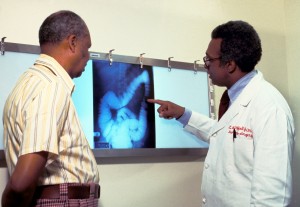
When a doctor can’t explain their patients' diagnoses and treatments in plain language, people suffer.
Poor health literacy -- a patient’s inability to understand health information – was first linked to poor health a decade ago. People who find their doctor’s advice confusing don’t manage their chronic diseases as well and are more likely to wind up hospitalized; among the elderly, the death rate is higher.
The public budget also suffers when patient and doctor don’t understand one another: in California low health literacy predicts lack of medical insurance, according to a first-of-its-kind survey published in the May issue of Health Affairs. Regardless of ethnicity, income or availability of employment-based insurance, if someone can’t understand their doctor or their pharmacist, they are less likely to have medical insurance. At the national level, health care expenses are increased three to six percent [pdf] by low health literacy; of that increase, 66 percent is public money, either Medicaid or Medicare.
Health literacy is also correlated to other types of literacy -- almost one in four California adults cannot use written English at a basic level. That means more than nine million people and their children are at increased risk of missing out on important health screenings, and are more likely to wind up in the emergency room.
With such a pervasive problem, improvement will likely result from a mix of approaches rather than a single magic bullet. Several strategies have proven effective. For example, patient education is more successful when the essential information is presented first and with a minimum of distraction. Another successful strategy, called “teach back,” increases comprehension during appointments. Patients “teach back” by using their own words to explain what they just heard their doctor say. This gives the doctor a valuable opportunity to correct misunderstandings.